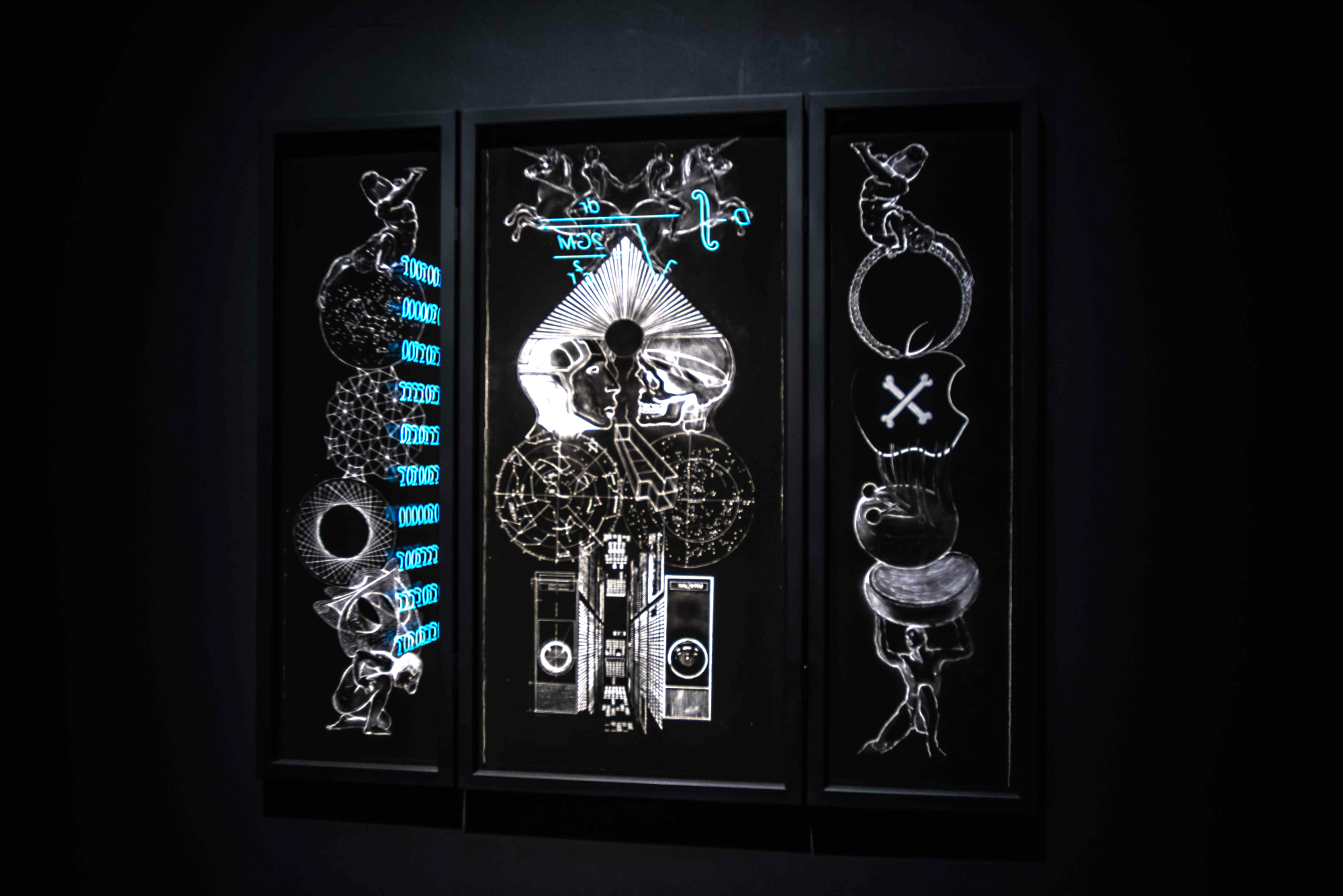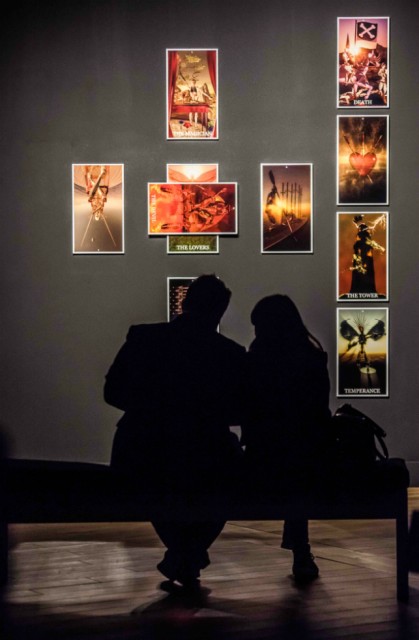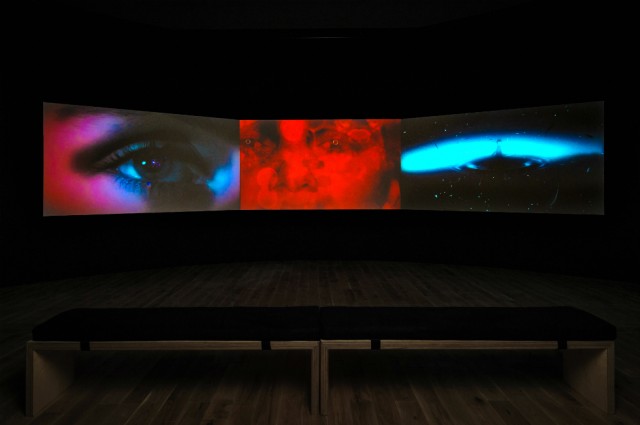AL And AL: Incidents Of Travel In The Multiverse — Reviewed

Combining clever forethought with mythology and modern physics, Vanessa Wheeler explores AL and Al’s new exhibition at HOME, Manchester; that takes you back — and forward — in time…
Astronomy meets astrology currently at Cornerhouse’s new Manchester venue, HOME; taking visitors on multiple and intertwining journeys through spacetime via British artists and filmmakers AL and AL. Entitled Incidents of Travel in the Multiverse, the exhibition is curated by Bren O’Callaghan and HOME director Sarah Perks, friends who first worked with AL and AL in 2011 when Cornerhouse commissioned the artists to create a short film to commemorate Alan Turing‘s centenary. This film became a remarkable and idiosyncratic work called The Creator in 2012; but more on that later.
Incidents of Travel in the Multiverse begins in a vestibule of dark, sloping angles, small exhibition catalogues and a solitary chalk drawing on paper, Pollux and Castor (2015). In Greek mythology, Castor and Pollux were twins with different fathers — a scientific rarity known as superfecundation — leaving one mortal and one immortal. Following the death of Castor, Pollux asked the gods to share his immortality, and together the twins forever became the constellation Gemini.
Inspired by the eternal brothers, AL and AL, whose shared names and self-declared soulmate status make them doppelgängers in their own right, play the folklorish notion of ‘the double’ combined with ideas from modern physics. The piece features a diagram of a wormhole seeping out of the back of one twins’ head whilst he toys with a Calibi-Yau manifold: the six-dimensional space that led to string theory’s discovery of mirror symmetry. Symmetry which, cleverly premeditated, is ever-present in twins.
Such forethought was present in each of the collections of chalk sketches in the next step of the exhibition, The Drawing Room. The music paper of composer Philip Glass — who wrote the soundtrack for AL and AL’s 2010 film Icarus at the Edge of Time — was used as the base for a collection of seven sketches which formed a septych inspired by Icarus himself. The drawings evolve to tell a story, and the final piece is titled Icarus (Before and After Draper) (2010); a reference to The Lament by Herbert James Draper, as his famous oil painting depicted the death and fall of Icarus after he flew too close to the sun. This display of quintessential sketches, perfect from the precision of the mathematical mark-making right down to the calculated placement upon the wall, is a moment of celestial enchantment and certainly one of the highlights.

AL and AL’s aforementioned film, Icarus at the Edge of Time (2010), is also on display. Based on the book by Professor Brian Greene, who collaborated with AL and AL and Glass on the project, it follows a futuristic young Icarus who flies into a black hole, instead of the sun like in the traditional tale. This notion of myth meets sci-fi is woven into the entire concept of Incidents of Travel in the Multiverse; painting science and fable with different strokes of the same — paint or animation — brush.
The next room screens the aforementioned The Creator (2012); perhaps the artists’ most well-known film. Here, artificially intelligent robots travel back in time to discover their creator Alan Turing, observing the last moments of his life, including the reoccurring dream that haunted him and his psychotherapist who tried to help. Excitingly, this film is set to be remade as a full feature-length film for cinematic release in 2017.
The adjacent room is set aside for Superstitious Robots (2011), a film focused on two machines who go to a tarot reader before deciding to get married. Another room named RoboTarot displays their selected tarot cards framed on the wall. The CGI used was awkward, outdated, and reminiscent of what Mark Leckey calls the ‘aboriginal shudder’: the sensuality of physical things manifested on screen. Yet it was easy to look past the strange visual effects and instead focus on the unadulterated ideas of superstition and love which predate any such technology. This focus on psychic readings is a homage to the last days of Turing; week before his suicide, Turing visited a soothsayer in Blackpool who read his tarot cards. He left utterly spooked — peculiar for a man of such logic — and soon after he was dead.
A stunning neon piece entitled I Love You (2016) sits in the centre of the show. Written entirely in binary code, the translated piece is a reminder of Turing and the prosecution he faced simply for loving; a crime that he was posthumously pardoned for only in 2013. Turing’s first love inspired the triptych drawing Delphinus (for Christopher Morcom) (2012), which reunited Turing and his teenage lover Morcom, who died aged 19, as a constellation in a multiverse of their own.

Passing more divinely inspired technical chalk drawings, and a film, To Be Rendered (2000) — which uses ‘databending’, a subtype of glitch-art, to convey the breakdown of a computer pushed beyond its processing power — the exhibition’s denouement is with The Demiurge (2016), an installation space hidden down a tiny corridor.
Taken from Bart Hoogenboom’s recent and ‘real’ images of DNA, and Francis Crick’s theory of panspermia, that life originated from microorganisms, the film tells the story of genetically modified clones trying to find a cure for death. With heavy scientific and philosophical undertones, the film’s dream-like haze merges the fields of science-fiction and actual future scientific possibilities — will humanity ever defeat our last ailment: death?
The aesthetic beauty of their drawings, the glaring curiosity of their neon, and the futuristic wonder of their films all merge together to express what AL and AL want us to understand: that science and art are the same thing.
Vanessa Wheeler
Visit AL and AL: Incidents of Travel in the Multiverse at the HOME, Manchester, until Sunday 10 April 2016 — FREE
Exhibition open Tuesday to Saturday 12-8pm and Sunday 12-6pm
See more from AL and AL on their website





